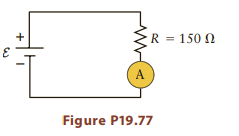Although an ideal ammeter has an internal resistance of zero, this theoretical ideal is usually not met
Question:
Although an ideal ammeter has an internal resistance of zero, this theoretical ideal is usually not met in practice. The ammeter in Figure P19.77 has an internal resistance of 0.010 V and is used to measure the current in a circuit containing a resistor with R = 150Ω as shown. How much does this nonideal ammeter affect the circuit? That is, what is the fractional change in the current when the ammeter is attached?

Fantastic news! We've Found the answer you've been seeking!
Step by Step Answer:
Related Book For 

College Physics Reasoning and Relationships
ISBN: 978-0840058195
2nd edition
Authors: Nicholas Giordano
Question Posted:





